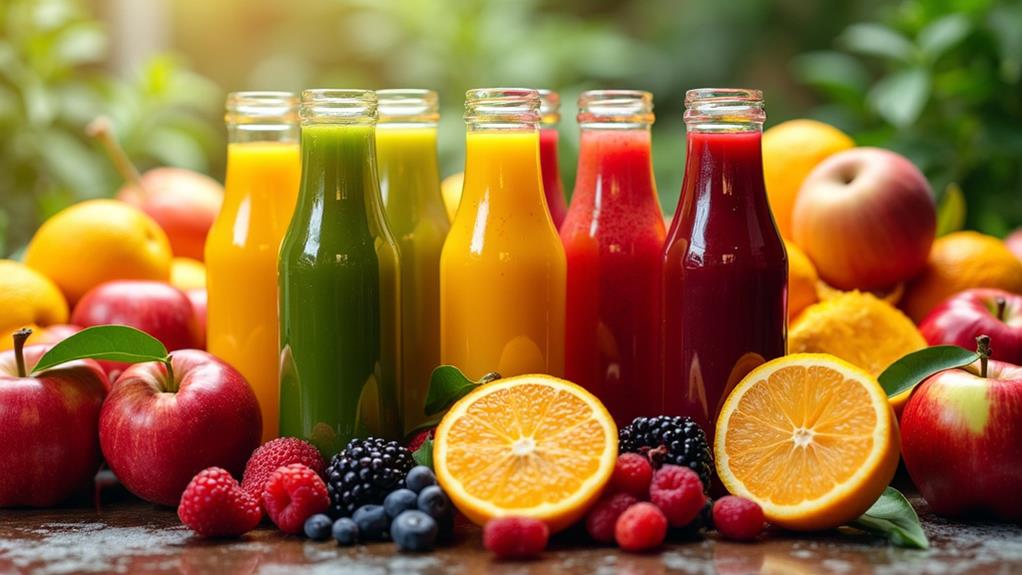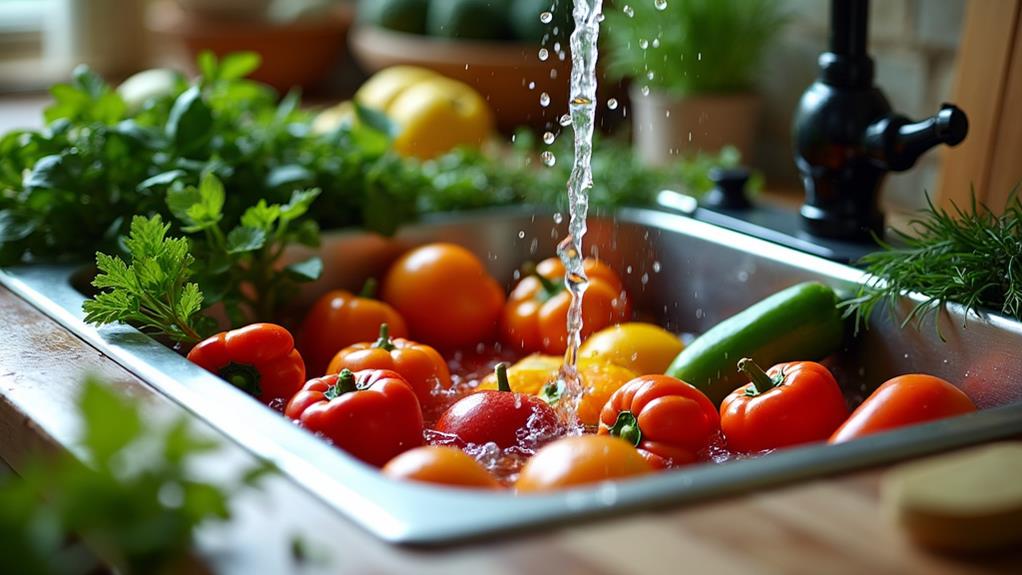Are Manual Juicers Worth It? A Quick Guide
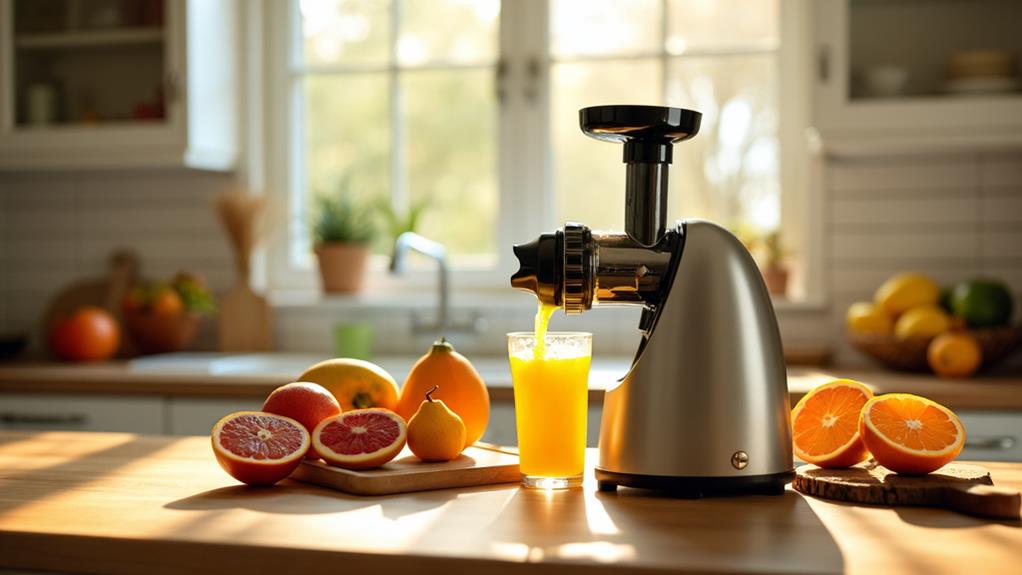
Manual juicers can be a fantastic investment if you enjoy fresh, homemade juice without the hassle of electric machines. They're affordable, with some models like the Chefn Juicester priced around $17, and they often yield more juice than their electric counterparts, like the Chefn FreshForce with its 38.22% yield. Their compact size is perfect for small kitchens, and many are easy to clean—often dishwasher-safe. However, they do require more elbow grease and may not suit high-volume juicing. If you value control over extraction while savoring each step, consider exploring more options and insights.
Understanding Manual Juicers
Manual juicers offer a practical solution for anyone looking to extract juice efficiently without relying on electricity. If you're aiming to enjoy fresh juice without cluttering your kitchen with bulky appliances, manual juicers are your best bet. They're designed for effective juice extraction, often outperforming electric models with a higher juice yield. For instance, handheld juicers like the Chefn FreshForce can achieve a 38.22% yield in just over five minutes.
You'll find a range of types of juicers to suit your needs, from handheld reamers to countertop presses. Each type caters to different preferences, balancing ease of use and cleaning. The OXO Good Grips 2-in-1 Citrus Juicer is a notable example, combining functionality with cleaning convenience. It's dishwasher-safe, making cleanup a breeze.
If you're on a budget, manual juicers are typically more affordable than their electric counterparts. Models like the Chefn Juicester, priced around $17, offer a budget-friendly option without compromising on quality. Plus, manual juicers are perfect for small batches, ensuring easy storage in your kitchen. They're a smart choice for anyone seeking a cost-effective, space-saving way to enjoy fresh juice.
Advantages of Manual Juicers
Although electric juicers have their perks, opting for manual juicers gives you several distinct advantages. To begin with, manual juicers like the Chefn FreshForce Citrus Juicer are incredibly efficient, achieving up to 38.22% juice extraction in less than six minutes. This efficiency makes them perfect for quick and convenient juicing tasks. Additionally, they're easy to clean, with many being dishwasher-safe, saving you time on cleanup compared to electric models with multiple parts.
Manual juicers also offer greater control over juice extraction, allowing you to prevent bitterness from the pith, which guarantees a fresh flavor profile in every glass. This level of control is perfect if you're particular about the taste and texture of your juice. Moreover, their design is typically compact, meaning they fit easily in kitchens with limited counter space, making them ideal for those who appreciate minimalism or need compact storage solutions.
Handheld models, like those from Zak Designs, improve your juicing experience by directing juice neatly into a container while efficiently capturing seeds and pulp. This mess-free approach makes manual juicers not only practical but also a delight to use daily.
Disadvantages to Consider
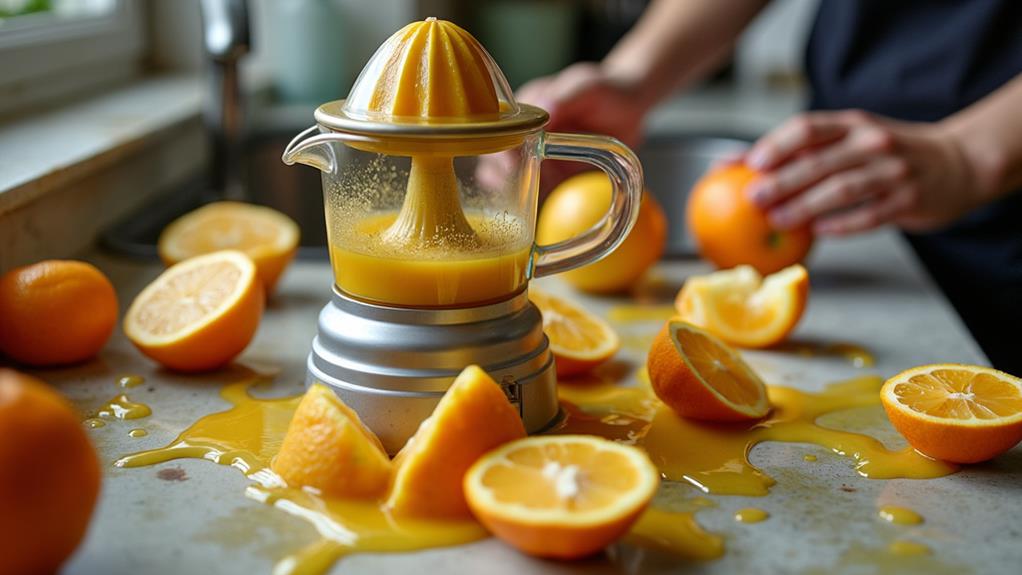
While manual juicers offer several appealing benefits, it's vital to weigh these against a few drawbacks. One significant disadvantage is the physical effort required. Manual juicers demand considerable hand strength, which can lead to fatigue, especially during extended sessions. This makes them less ideal if you're planning high-volume juicing. Instead, they're better suited for small batch preparation, where you can enjoy the process without overexerting yourself.
Another downside is the potential for lower juice yields. Many handheld models depend heavily on your strength, like the Zulay Lemon Squeezer, which might leave some juice behind. This inefficiency can be frustrating when you want to make the most of your produce. Moreover, cleanup can become a chore. Manual designs often trap pulp and seeds in tricky spots, requiring thorough hand washing. Unlike some electric models, which offer dishwasher-safe parts, manual juicers demand more time and effort to maintain.
Lastly, the efficiency varies greatly among different manual juicer designs. Some lack built-in strainers, resulting in unwanted pulp in your juice, affecting its smoothness and overall enjoyment. Considering these disadvantages, it's important to assess if a manual juicer aligns with your juicing needs.
Comparing Juicer Types
When evaluating different juicer types, it's essential to reflect on how they fit into your lifestyle and kitchen space. Manual juicers, like handheld reamers and countertop presses, shine in their compact design, making them perfect for kitchens with limited counter space. They offer easy storage and straightforward cleaning, with many models being dishwasher-safe. This simplicity provides you with more control over the juicing process, allowing you to extract juice without the bitterness from the fruit's pith—a common issue in electric juicers that might over-ream.
Regarding juice yield, manual juicers often outperform in smaller quantities. For instance, the Chefn FreshForce achieves a 38.22% yield, surpassing manual hand juicing's 30%. This makes manual juicers a great option for those who need just a glass or two of fresh juice.
However, if you're aiming for larger batches, electric juicers offer greater efficiency and speed. They're designed to handle bulk juicing with ease, although they come with more complex parts, making cleaning more time-consuming. Ultimately, the choice between manual and electric juicers boils down to how often you juice and the quantity you need.
Key Features to Look For
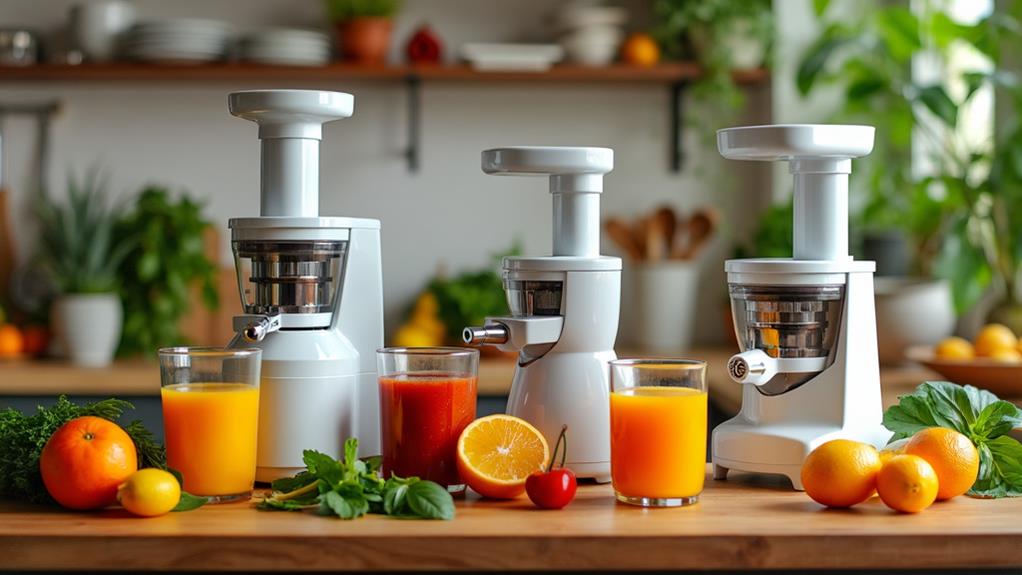
Selecting the right manual juicer involves focusing on key features that improve efficiency and convenience. Efficient juice extraction is vital; for instance, handheld juicers like the Chefn FreshForce achieve an impressive yield of 38.22% in under six minutes. This guarantees you get the most out of your fruits without wasting time. Ergonomic design is another significant factor. Models such as the KitchenAid Citrus Squeezer prioritize comfort and ease of handling, reducing strain during use and making juicing a more pleasant task.
Don't overlook the ease of cleaning. Opting for a dishwasher-safe juicer, like the OXO Good Grips 2-in-1 Citrus Juicer, can save you significant time and effort in maintenance. To minimize mess, built-in strainers and juice collection cups are fundamental features. They prevent pulp and seeds from spilling, keeping your kitchen clean and your juice pure.
A flexible juicer with interchangeable reamers, such as the Chefn Juicester, is ideal for handling different citrus sizes. This adaptability allows you to juice various fruits without needing multiple tools. Focusing on these features guarantees you select a juicer that meets all your needs efficiently.
Top Manual Juicer Picks
If you're in the market for a manual juicer, several top picks stand out for their performance and convenience. The Chefn FreshForce Citrus Juicer is a standout option for its efficient juice extraction, yielding an impressive 38.22% from lemons and limes in just over five minutes. It's a perfect choice if you need quick juicing results. For those with sensitive wrists, the KitchenAid Citrus Squeezer offers ergonomic handling with its compact design, making it ideal for countertop use without straining your hands.
The Chefn Juicester Citrus Juicer provides versatility with dual reamers, perfect for extracting juice from both lemons/limes and oranges. This manual juicer delivers a higher juice yield and guarantees comfortable use. If you're looking for a practical solution that includes a measuring cup, the Oxo Good Grips 2-in-1 Citrus Juicer is a great pick. It comes with reamer attachments suitable for different citrus sizes and is dishwasher-safe for hassle-free cleaning.
For budget-conscious buyers, the Zak Designs Handheld Citrus Melamine Reamer offers decent juice extraction in a compact and affordable design, making it a practical choice for small quantities.
Maintenance and Cleaning Tips
Cleaning and maintaining your manual juicer properly is vital for its longevity and best performance. Many manual juicers, like the Chefn FreshForce and KitchenAid Citrus Squeezer, are dishwasher-safe, making cleaning after juicing a breeze. However, don't let the convenience of a dishwasher replace timely maintenance. You should clean your juicer immediately after use to prevent residue buildup, especially in tricky areas like hinges where pulp can get trapped.
While some juicers are dishwasher-friendly, hand-washing is often recommended, particularly for hinged squeezers. This practice helps maintain their functionality and protects them from the potential deterioration caused by prolonged moisture exposure. Regular maintenance, such as rinsing the detachable parts and using mild soap, is important for guaranteeing your manual juicer continues to perform at its best.
To tackle stubborn pulp and citrus oils, using a soft brush can be very effective. This helps in thoroughly cleaning reamers and strainers, guaranteeing the best juice extraction and keeping your juicer in top shape for future use. By following these cleaning and maintenance tips, you'll guarantee your manual juicer remains a reliable tool in your kitchen for years to come.
When to Choose Manual Juicers
Reach for a manual juicer when you want a hands-on juicing experience that offers control over flavor and extraction. If you're working with small quantities of juice, manual juicers are ideal. They provide the opportunity to fine-tune your juice's taste, especially when dealing with citrus fruits. The extraction process captures vital oils and flavors that electric models might miss. You'll also enjoy a higher juice yield; some handheld models achieve up to 38.22% juice yield, outperforming many electric options.
Manual juicers are compact, requiring minimal storage space, perfect for kitchens with limited room. They don't clutter your counters and fit neatly into cupboards. Cleaning is a breeze, too. Many manual juicers are dishwasher-safe, making maintenance straightforward and quick. You won't need to spend time disassembling complex parts like with some electric juicers.
Choosing a manual juicer means opting for an easy-to-use tool that delivers fresh juice efficiently. If you value simplicity and convenience, and want to avoid the noise and hassle of larger machines, then a manual juicer is a smart choice. It's about maximizing flavor and efficiency with minimal fuss.


